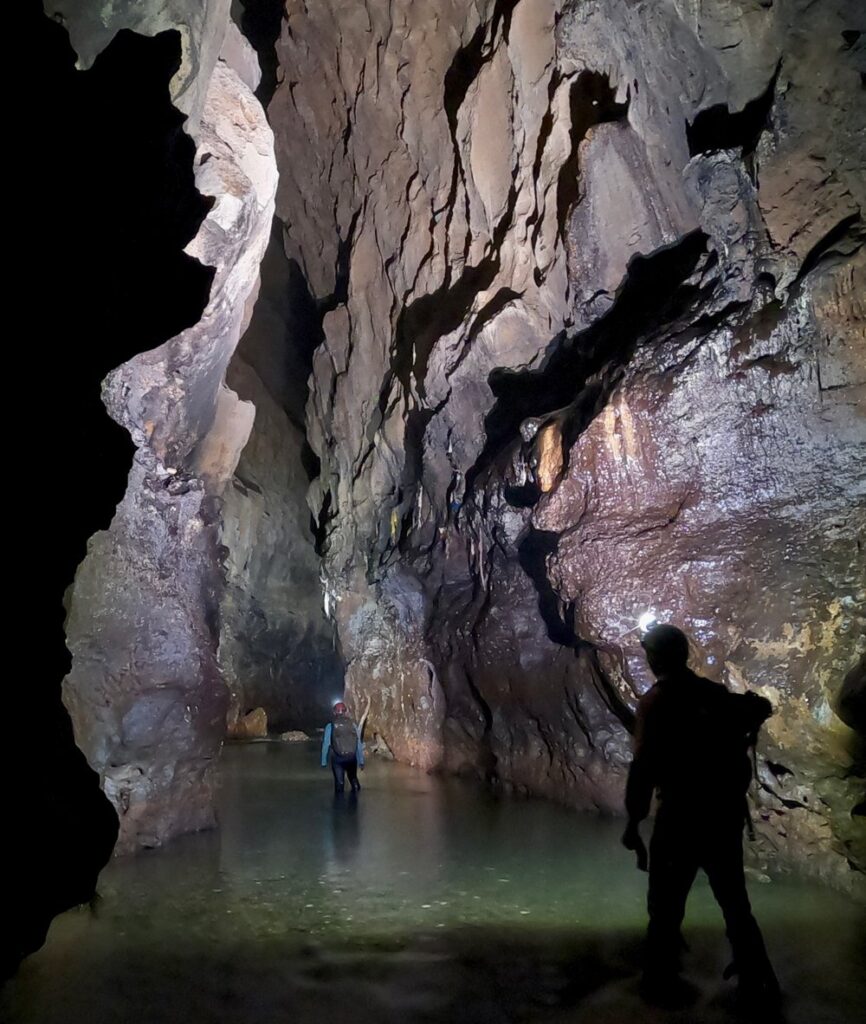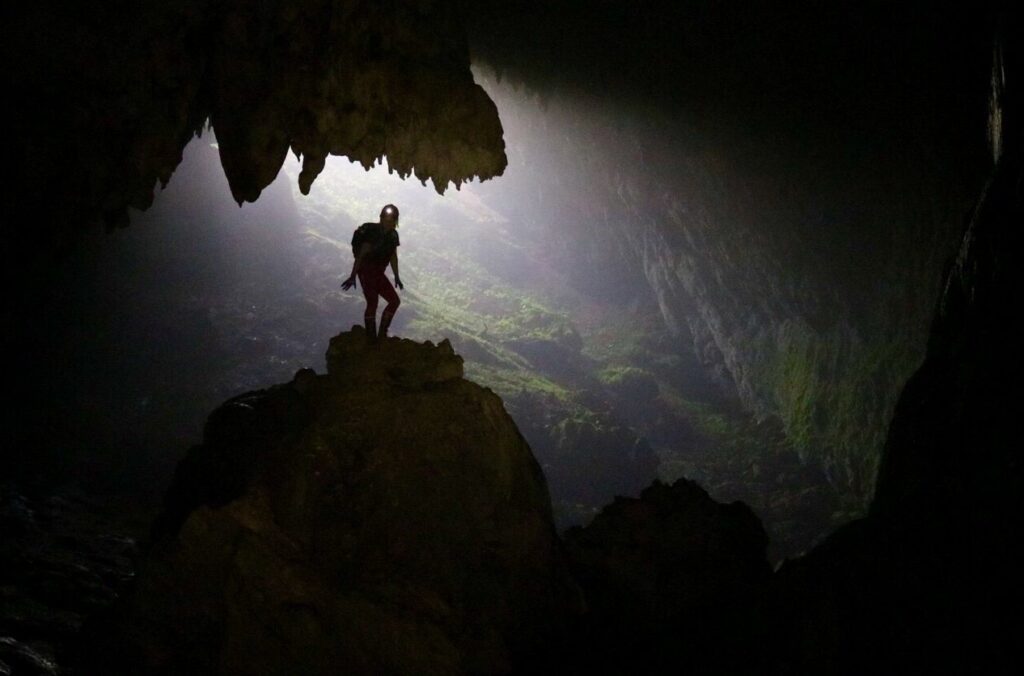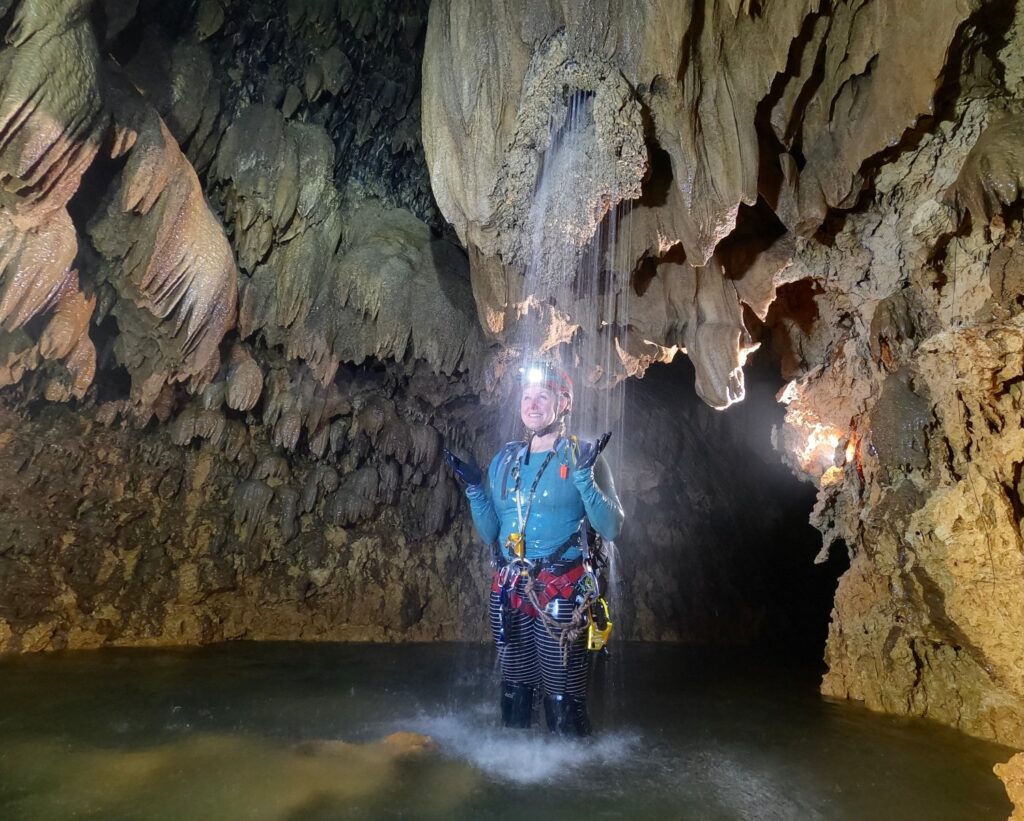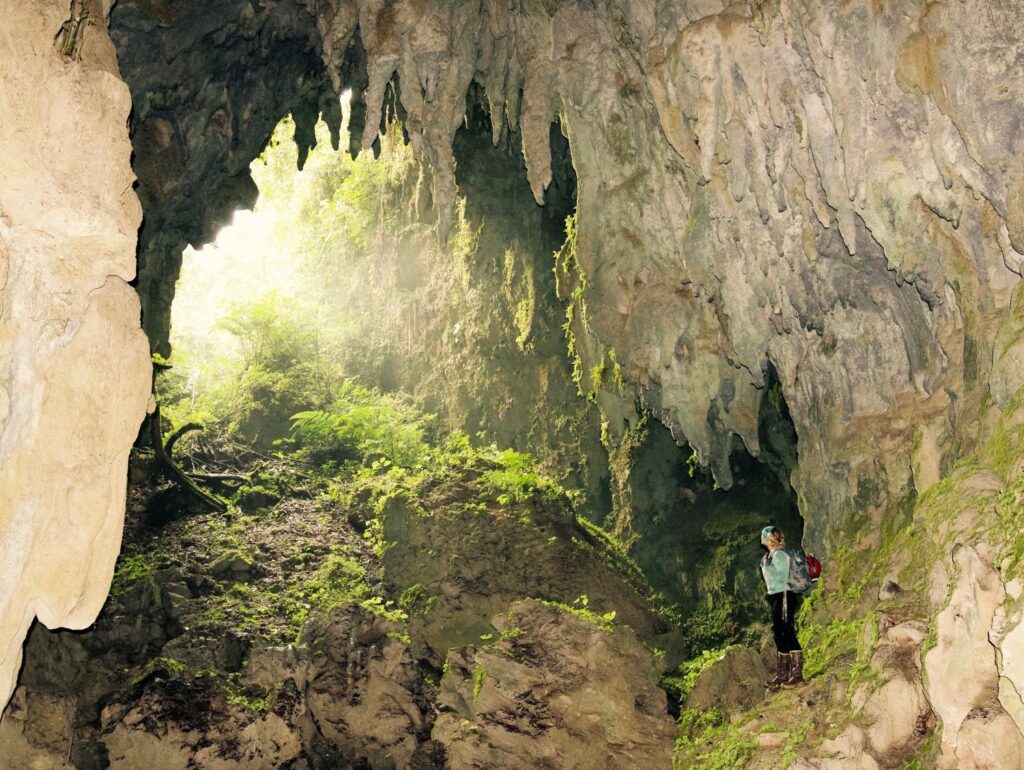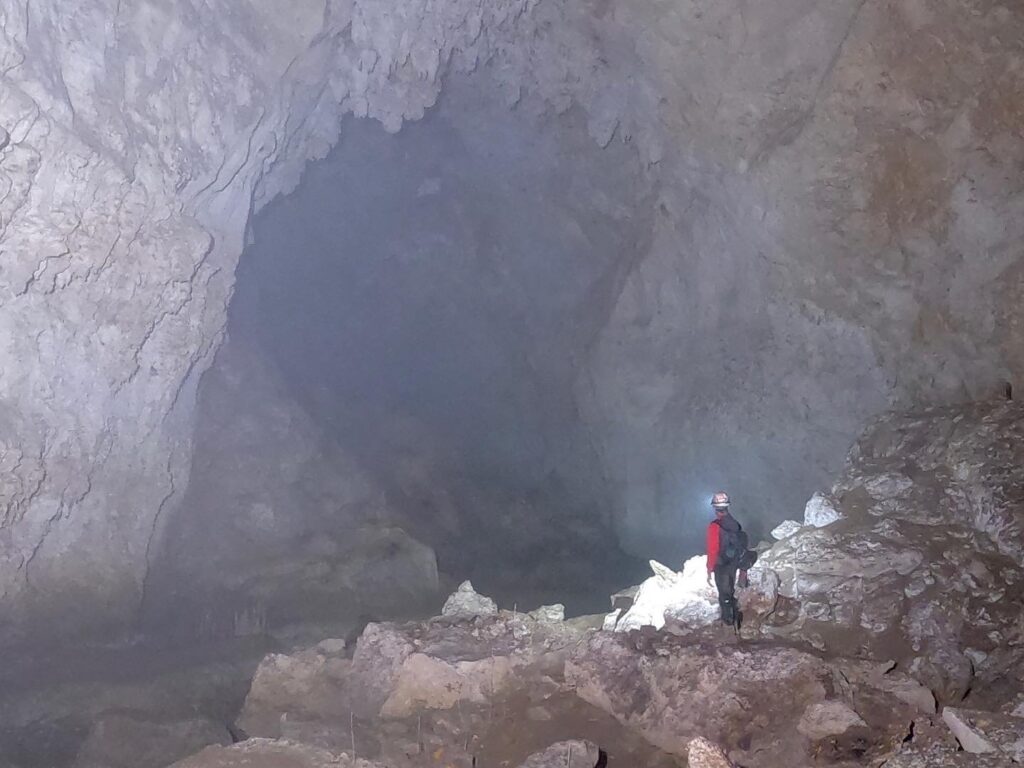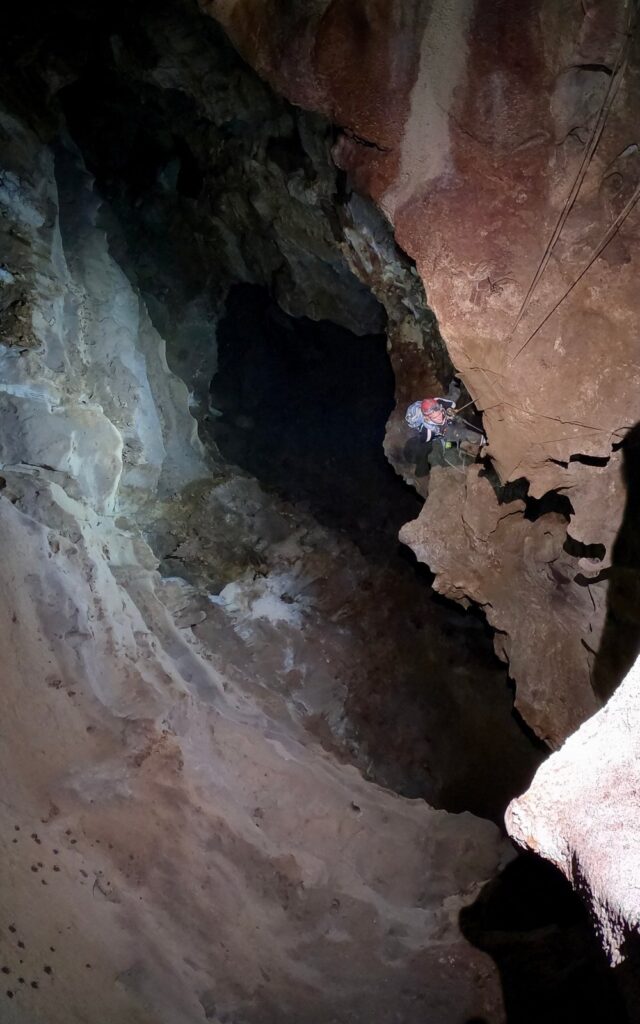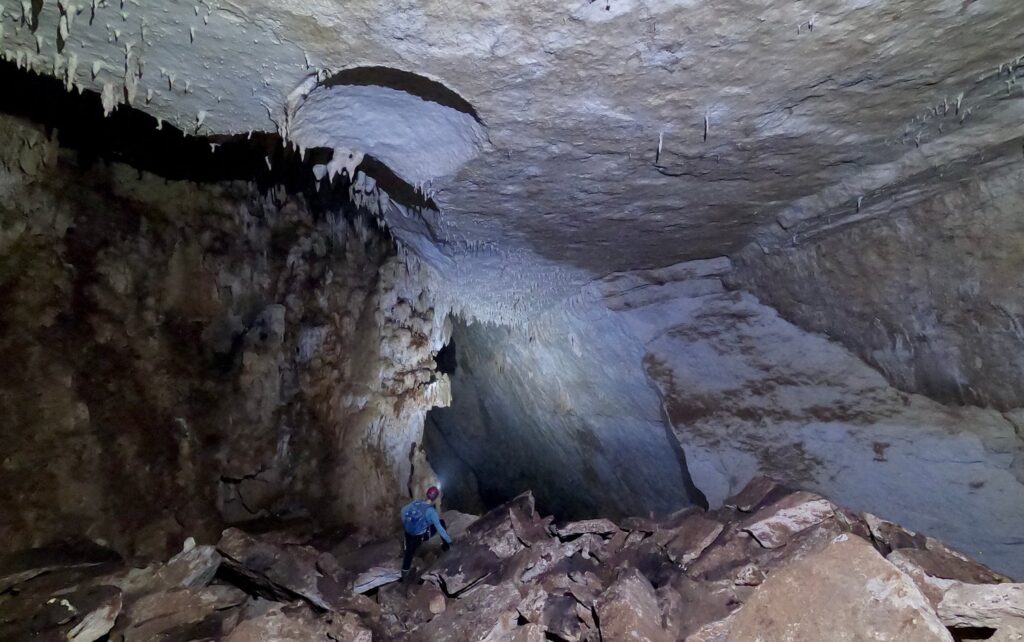The Lost Kingdom
Feature type Story
Read time 15 min read
Published Nov 02, 2021
Author David Weimer
Photographer David Weimer
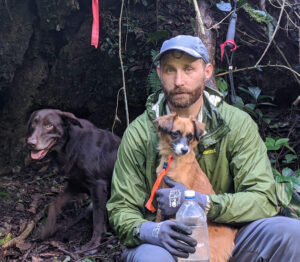
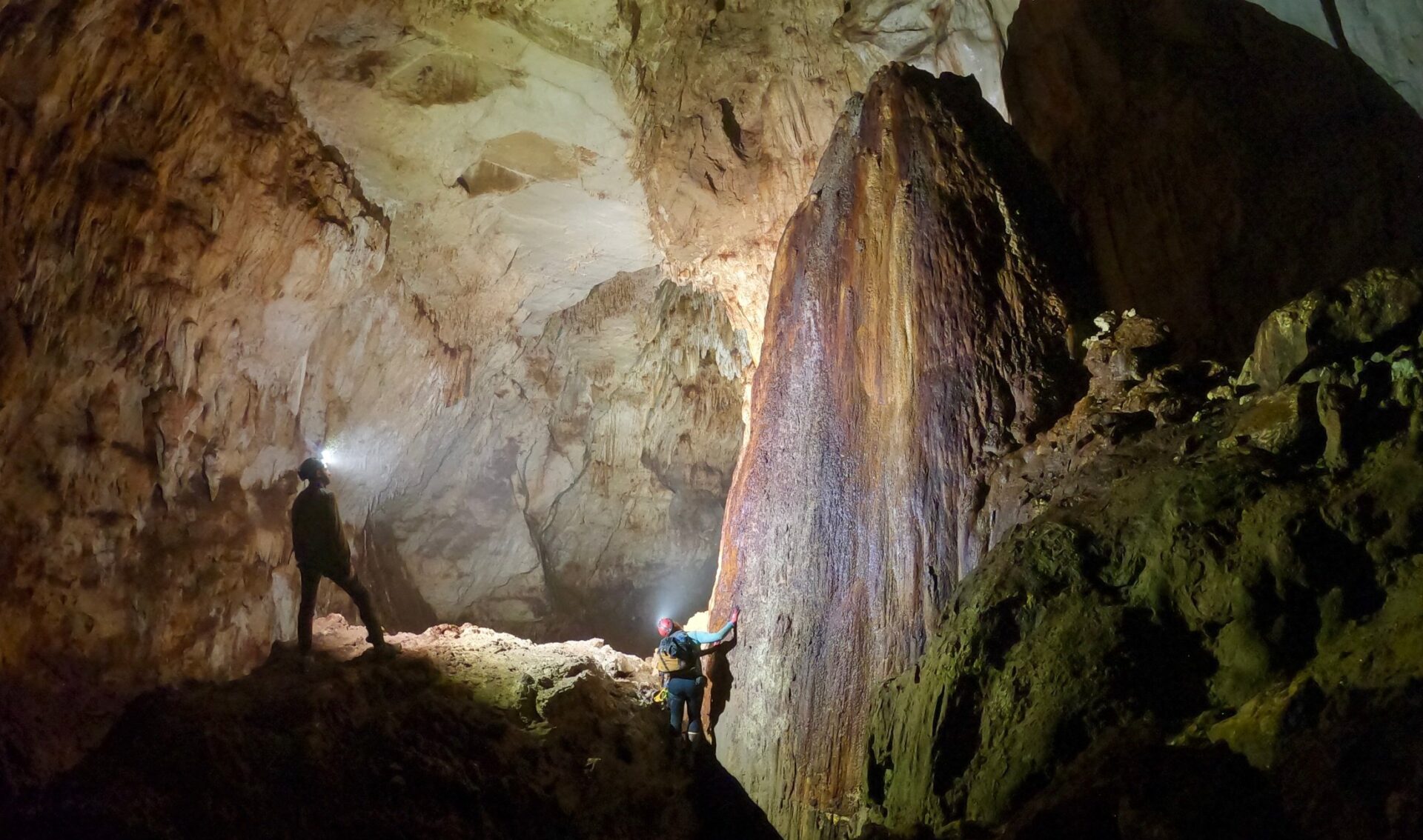
“Tenga cuidado,” (be careful) he warned. The store-keeper guided Russell and Jeanne Gurnee a short distance, just across the road from the parking lot. Sí, there were caves in the area, and sí, he could show them one. The man pulled back a curtain of vines and to their complete surprise, an enormous pit was revealed — at least 100-feet in diameter. The cavers from New Jersey gasped as they took in the immensity of what they were seeing. The edge of the mighty sinkhole was overhanging, and the jungle — perched precariously at its lip — leaned inward as if trying to get a better look. The couple crawled on their stomachs, getting as close to the edge as they dared. The pit appeared bottomless, but the telltale roar of rapids — El Rio Camuy — could be heard echoing, hundreds of feet below.
The year was 1958. The sight of Empalme Pit would mark the beginning of the Gurnee’s obsession with the Rio Camuy’s underground labyrinth. In time, they would organise and lead four major expeditions to the island, which would reveal the Camuy as being the third-largest underground river in the Western Hemisphere. Some of the caverns they discovered were so huge, their meagre lights could not sufficiently illuminate them; only bursts of flash-powder could produce enough lumens to momentarily reveal their scale.
Thanks to the Gurnees, the land above the caves was eventually purchased and the Parque Nacional de las Cavernas del Río Camuy was created. Lights were wired, boardwalks and stairs erected, even a trolley was installed. The park could support 1,500 tourists a day and was readily sold out. Prior to 2008, it was the most popular natural attraction on the island.
But over the years the park saw its fair share of tragedy. In 1968, Hector Bueso, aged 30, was on a guided tour of Tres Pueblos Sinkhole, when the river suddenly flooded and swept him into the downstream cave entrance; his body was never recovered. In 1975, Francis McKinney — an experienced caver who had been awarded the prestigious National Speleological Society’s Fellowship Award — fell 75-feet to his death while climbing out of the Ventosa entrance. In 1999, Francis Reyes, a caving instructor and guide, drowned during a flood pulse in Cueva Angeles (although technically not inside the park, Cueva Angeles is part of the larger Camuy cave system). In 2008, Socorro Elain Smith, a tourist from California, was killed by a falling rock while waiting with her husband to board the trolley out of Tres Pueblos Sinkhole. In 2011, an employee of a zipline operator, Jorge Len Rivera, aged 34, drowned while installing a cable across Tres Pueblos Sinkhole when a flood pulse swept him into the downstream cave entrance. In 2016, María Lisardi Vázquez, a 32-year-old zipline operator, lost her footing and fell over 400-feet into Tres Pueblos Sinkhole. The Sistema Camuy has claimed more lives than any other cave or cave system in Puerto Rico; most of them technical experts.
By 2009 the park was falling into disrepair. The long boardwalks which provided tourists access to cave entrances and observation decks were beginning to rot. Fallen trees and landslides blocked the roads. With astonishing speed, the jungle was reclaiming the land.
Then came the final blow. Maria, the category-5 hurricane which devastated the island in September of 2017. The amount of water which flooded the caverns was biblical. Tres Pueblos Sinkhole flooded to an instant lake with an estimated depth of over 200-feet. Many of the tourist facilities were destroyed or washed away. It appeared the cave’s large bat populations had either been wiped out or evacuated. The park was unceremoniously closed, and has been ever since.
The closure of one of Puerto Rico’s most popular natural attractions has been detrimental to the local community and the loss of state revenue for an already struggling economy has done little to help its future prospects. However, the Federal Emergency Management Agency (FEMA) has allocated 14 billion dollars in disaster relief since 2017. In August of 2020, an additional 84 million was allocated for recovery projects, and of that, 12 million was designated for repairs to parks and recreational facilities. Whether Camuy Park will receive any of that money is still to be decided.
The skin on my arms bubbled up and became infected. It looked like blisters from a third-degree burn and itched like hell
Like Jeanne and Russell before us, my partner Ashlee and I had become obsessed with the Camuy Caverns. We were residents of Puerto Rico, cavers too, and had spent many long weekends exploring the island’s karst. We had seen old, pixelated photographs of the park, and since our equipment was modern, we knew we could do better. We sensed an opportunity to photograph these magnificent caves the way the Gurnees saw them in 1958 – in their original state, before the guardrails. Perhaps our pictures could be used to garner attention and aid in the restoration of the park? It was a wonderful thought.
We tried a dozen times to request a permit from three different authorities but never received a response. The park entrance was guarded 24/7 and our Spanish wasn’t good enough for schmoozing. However, our research had shown there were other ways to legally access the caverns: areas outside of the park.
Blue Hole would be our first try at a backdoor. The Camuy begins as any other river which flows lazily across the surface of the land. Blue Hole is the point where the river burrows underground. We knew from the book Discovery at the Rio Camuy that the Gurnees had also employed this tactic. However, we wondered if anything had changed during their 60 year absence. Ashlee and I hiked to the river and walked downstream. We arrived at the base of a cliff and found a massive choke of logs, bamboo, and debris. Over a thousand years, every branch, twig, and leaf that had fallen into the river was piled here. It was the mother of all strainers. There were large driftwood logs 30 feet up into the trees, evidence that the area becomes a lake when flooded. To access the caves this way would require a great deal of explosives to remove the plug. How this curious spot ever got the name Blue Hole was a complete mystery to us.
Our next attempt would be through Cueva Humo – or Smoke Cave – so named for the great number of bats which can resemble smoke as they depart on their evening forays. I had a general idea where Humo was located but the information proved insufficient to say the least. The jungle was thick, nearly impenetrable. You could not go a step forward without first chopping a hole through the vegetation. There were ants everywhere, falling off the trees and down our collars and I soon became familiar with a little plant called Carrasco. Carrasco is related to poison sumac but its effects are much, much worse. Three days later I was in the hospital getting steroid injections. The skin on my arms bubbled up and became infected. It looked like blisters from a third-degree burn and itched like hell. Luckily for Ashlee, she did not have as severe a reaction as I did.
Our third try was the Camuy Resurgence – where the river reappears after travelling underground for several miles. We entered the cave with headlamps on and followed the river up-stream. The river was swift and in certain sections we’d swim against the current as fast as we could, momentarily clawing the wall to catch our breaths. In this fashion we pushed through several small chambers until our path was blocked, once again, this time by a large breakdown pile where the ceiling had collapsed. The water could squeeze through the cracks but we could not. We had failed… once again.
In our desperation we decided to join a caving club. It should be noted that I’m not a fan of clubs. Maybe because I’m an introvert. Or maybe it’s the associated fees I don’t like. Or maybe it’s because I’m wary of cults, and clubs seem to have a lot of similarities. Whatever the case, it had gotten to a point where we were spending too much time looking for caves and not enough time actually inside of caves. In fact, two weeks prior, we had spent an entire day looking for Cueva Perdida. The name translated is Lost Cave. After several hours of hacking at the jungle, promising my friends their efforts were worth the search, it slowly started to dawn on me how the cave got its name.
In desperation, I contacted Sociedad Espeleológica de Puerto Rico (SEPRI) hoping someone there spoke English. We met some very nice, interesting people and in time, made some very good friends. But that didn’t necessarily mean they were going to divulge the location of certain caves. Those, apparently, would need to be earned.
Our determination had been paying off elsewhere. We found the long lost Cueva Perdida after three tries and Cueva Humo after two. Neither had been visited since Hurricane Maria some three years earlier. We thoroughly explored 23 other cave systems on the island (often with friends from SEPRI) reopening the trails to each of them and gaining valuable experience along the way.
We had been dreaming of the Camuy Caverns for nearly two-years and it looked as though our employment on the island was coming to an end. We decided to refocus our attention entirely on Camuy. We had become cavers, after-all, and we were not about to leave Puerto Rico without seeing the most spectacular caves on the island.
In trying to find our way into the Camuy Caverns, Ashlee and I tried going through the front door at Blue Hole, we tried the side door at Cueva Humo, and we tried the backdoor at the Camuy Resurgence. The only entrance left seemed to be the chimney. La Ventosa – Spanish for ‘The Sucker’ – is an unassuming man-sized hole on the side of a hill. This small entrance leads to a balcony which overlooks a dizzying, 300-foot vertical drop to the Rio Camuy far below.
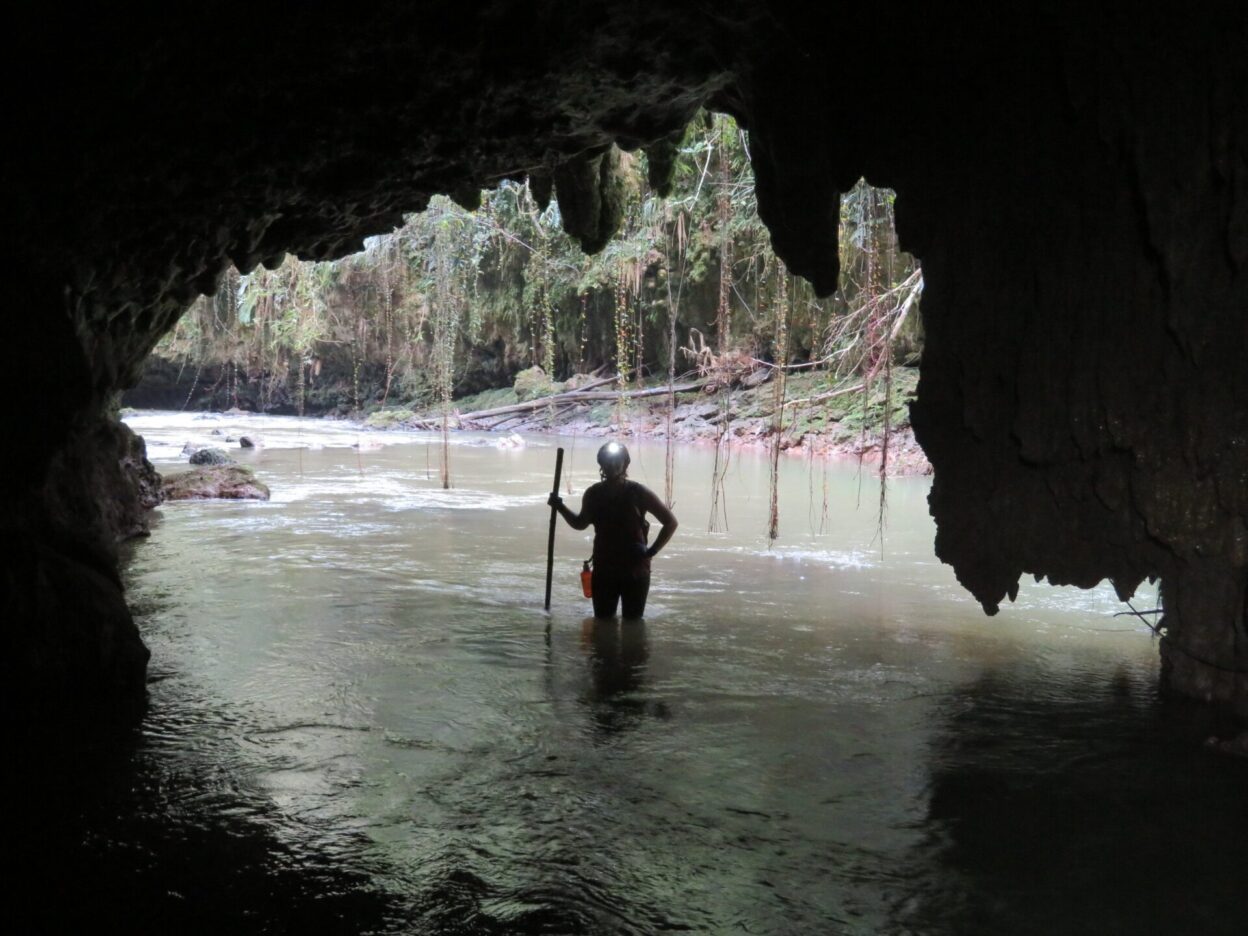
We hiked up the hill with our ropes and climbed over the barbed-wire fence which prevents cows and stray dogs from falling in the hole. There was a noticeable breeze as the vacuum of La Ventosa lived up to its name and lured us into the darkness.
With headlamps on we quickly negotiated a short 15-foot rappel and left the rope for our climb back out. Down at knee level was a descending crawlway. We squeezed down this chute and entered a large domed room which gave the impression the entire hill we had just been walking on was completely hollow. Carefully, we made our way to a balcony which overlooked a mighty abyss. The echoing rush of the river could be heard far below. We switched our headlamps to spot-mode but the combination of our focused beams was still unable to reach bottom. The total distance of both rappels would equal the height of the Statue of Liberty from torch to foundation.
There was an old but sturdy looking anchor. We added some webbing for insurance and threw the rope. For three and a half seconds it whipped through the air, finally hitting bottom with a muffled slap.
“Holy crap.” I said, “That was some serious airtime.”
Ashlee nodded. “This is going to be epic.”
Clipping my micro-rack into the rope, I tentatively walked backwards over the edge. I slowly descended off the balcony and away from the warm glow of Ashlee’s headlamp. I was soon bouncing off the cave wall like a moonwalker. It was unnerving not to be able to see the bottom of the pit, the white rope disappearing into the darkness below. Then the walls of the cave belled out and I was suddenly hanging free, slowly spinning down like a spider from its web. It began to dawn on me that the climb out would be much more difficult than I expected.
A boulder-strewn ground materialised below. The nylon rope began to smell of burnt rubber as I slowed my descent. Once my feet touched the ground, I unclipped the rack and took a good look at my surroundings. I was in the middle of a cathedral-like room, the cave continuing in both directions. It was as if I was standing in the middle of a huge canyon at night. It was by far the largest cave I had ever seen. I switched on the walkie-talkie.
“Okay Ashlee, I’m off-rappel. Please be careful.”
“Coming down,” she said cheerfully.
Far above, Ashlee’s headlamp resembled a solitary star in the night sky. I watched her begin the rappel, slowly bouncing down until the cave belled out and like me, she also began slowly spinning; this time her light resembling a lone firefly buzzing around in circles.
She touched down with a huge smile on her face. “Wow, that was incredible!”
“Not over yet,” I replied. “We’ve got another rappel.”
We gathered our bags and then flagged the rope with reflective tape which would make it easier to find in the large room. It was literally our lifeline. We had no communication with the outside world and needed to take every precaution available.
Just downhill was a house-sized stalagmite which thrust upwards like a mighty tusk. Stalagmites typically have a corresponding stalactite of equal or larger size hanging from the ceiling but it was too high and our lights too weak to see it. Stalagmites like ‘The Tusk’ form from drops of water which have picked up calcium bicarbonate in the limestone roof of the cave. As the droplets touch air, some of the dissolved rock turns back into limestone. In this way, stalagmites gradually grow mass and extend upwards layer by layer. It is a very slow process, growing less than 10cm every thousand years. ‘The Tusk’, with its monolithic proportions, is likely a hundred thousand years old.
We continued down the muddy slope, we knew there was another big drop but didn’t know exactly where. We thankfully found an old rope running horizontally along the wall. We attached ourselves with a carabiner and continued to the edge of the drop.
The edge was on an overhanging pedestal of limestone which looks like a candle that has melted all the way to the hilt. We tentatively peered over. Fine droplets of mist reflected our lights and prevented us from seeing bottom. The cacophonous rumble of rushing water was much closer now. I imagined rapids.
“I don’t know if we should do this,” I thought aloud.
Ashlee turned, temporarily blinding me with her headlamp. “What do you mean? Why not?”
“We can’t see the bottom,” I said, shaking my head. “It sounds like we’re going to rappel straight into the river and we don’t know how deep or fast it is. Sounds like it’s really churning down there. Besides, we already have a hell of a climb out. Maybe we should come back another time.”
“Another time?” Ashlee asked, confounded. “We did it, we’re here, and it’s so close.”
Her reaction made me smile. Typically these caving trips had been my harebrained ideas. On more than one occasion I led us on some wild-goose chase to some obscure hole in the ground where we’d find nothing more than filth and exhaustion; adventures that would test the resolve of even the most hardened relationship. But over time she had caught the caving bug too and now it seemed her determination to see the Rio Camuy was even stronger than mine.
“Okay,” I said with a weary smile. “Let’s do it!”
“When you get down to the river,” she said. “If it looks too deep, just do a change-over and climb back up.”
I nodded, feigning confidence. Although we’d practiced change-overs (the ability to switch from descent to ascent with the aid of rope-grabbing cam devices) many times at a local crag, doing one on a hanging rappel, 300-feet underground, above a frothing river – was a nausea-inducing proposition.
Swallowing my hesitation, I threw the rope and began the descent. Even halfway down, the mist swirling around my feet prevented me from seeing bottom. The nearest wall began to look wet and polished, the roar of rapids getting ever louder. Finally, the mist parted and I did not like what I saw. The cave appeared to be bottomless, the void continuing to infinity. I looked to see how much rope I had left. It looked as if a great wind was blowing the rope back up towards me! I suddenly realized it was an optical illusion. The river below was calm and clear making it look black in the reflection of my headlamp. The end of the rope was floating in the water. Down-canyon the river cascaded through a sieve of large boulders. It was hard to determine how deep the river was, so I slowly lowered myself into the water. I thankfully touched ground at thigh level.
I waded to a nearby gravel bar and radioed Ashlee who was down to the river in a matter of minutes. I took a video as she rappelled into the Rio Camuy – a moment we had been dreaming about since we started caving on the island some two years before. I waded back into the water and we hugged. It was a short celebration, however. We were in the belly of the beast now; congratulatory speeches could come later.
Upstream, the Camuy River flowed placidly through a slot canyon with high vertical walls. It reminded me of The Narrows – a popular destination in Zion National Park, Utah which frequently sees hundreds of visitors a day. If we continued in that direction, we’d eventually make it to the Hall of the White Maidens: so named for the gallery of statue-like formations that resides there. However, we were more interested in seeing the enormous dimensions of the Big Room and the twisting house-sized skylight of Cueva Espiral which opens up 300 vertical-feet above the surface of the river.
We hiked downstream until our path was blocked by a pile-up of large boulders and the thrashing rapids we had heard from above. We attempted to circumvent the obstacle by scrambling up and over the boulders. There had been an accident in this area during the 1962 Gurnee Expedition when a member of the party, Joe Lawrence, had trusted his weight to a boulder the size of a refrigerator when it unexpectedly rolled, throwing him from the rock and then trapping his arm beneath it. The team rushed to his aid, frantically scratching at the dirt and rock around his arm until they freed him. Unlike Joe, we did not have a team of rescuers at our side if such an event were to happen to us. We agreed that we had pushed our luck enough for that day. Also, the sure-to-be-exhausting rope ascent lingered.
Ashlee and I took one last look around, the beam of our lights crisscrossing through the blackness. Our eyes strained to see the wonders surrounding us. We were filthy, hungry, and soaking wet. But at that moment, we had an entire National Park to ourselves. In our minds, it was as close to buried treasure as we were ever going to get.
The ascent up the ropes was long but uneventful. Outside the cave entrance, night had fallen and the jungle had come alive with a symphony orchestrated by frogs and insects. As we hiked to the car, I couldn’t help but think of the natural wonders in the ground below our feet. All that beauty and grandeur hidden in the darkness for no one to see.
But then it happened: On March 24th, the Parque Nacional de las Cavernas del Río Camuy reopened and was allowing visitors for the first time in nearly four years. Only one cave was accessible, Cueva Clara, and only 20 visitors a day could see it. But hell, it was better than nothing. Ashlee and I got in the car and rushed to the park entrance. There wasn’t a line or any cars in the parking lot, but when we pulled up to the entrance with smiles on our faces, the guard informed us that all the tickets were sold out. I couldn’t help rolling my eyes.
For now, most of the spectacular formations of the Camuy will remain in the dark, waiting for some brave and determined individuals to open the doors wide and share them with the world.
Don’t miss a single adventure
Sign up to our free newsletter and get a weekly BASE hit to your inbox
Other posts by this author
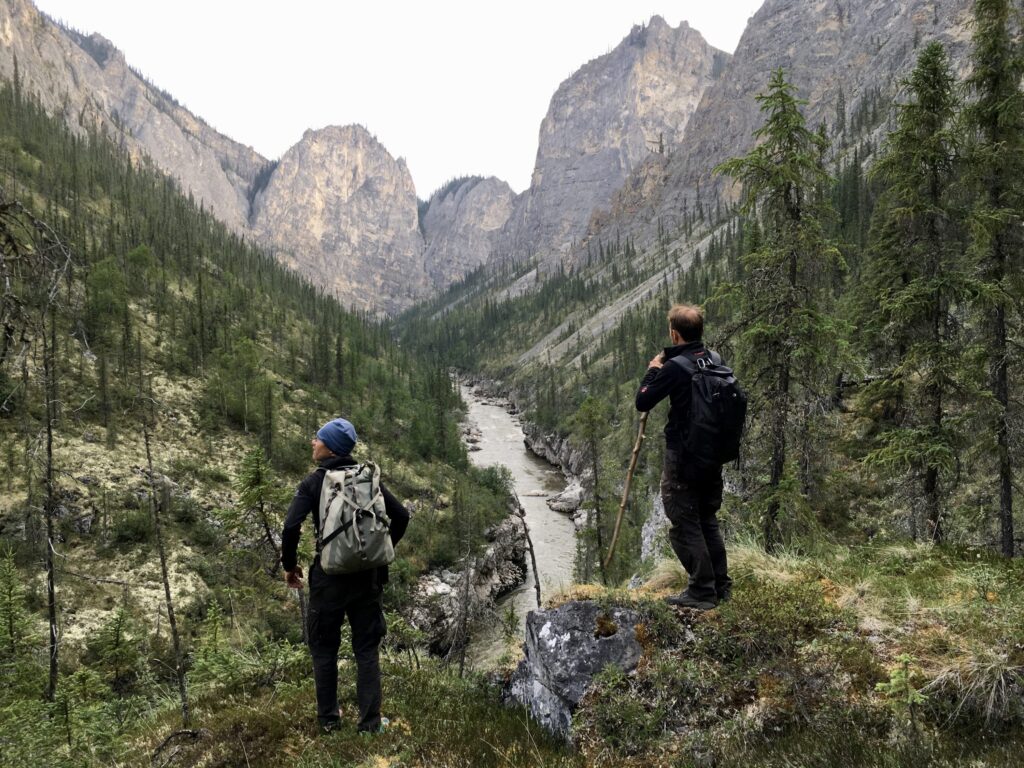
Story • David Weimer • May 10, 2022
Savage Paradise
Packraft exploration of the Tatonduk Valley – Yukon Territory
You might also like
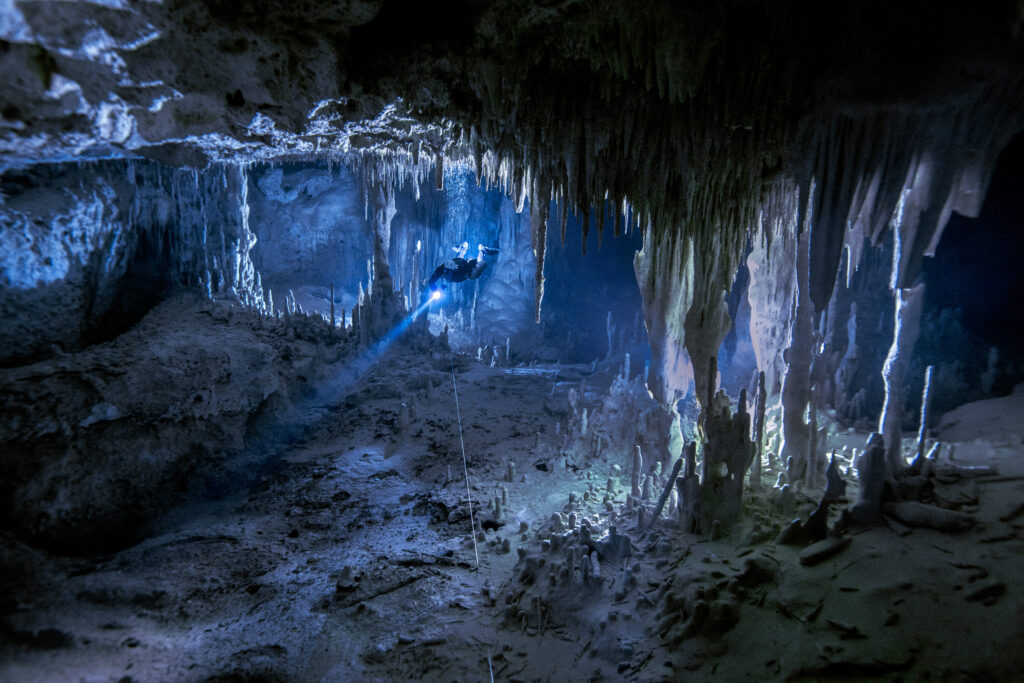
Story • Ben Horton • Jun 28, 2022
A Deeper Understanding
Lessons in facing the unknown in Mexico's underwater cave systems
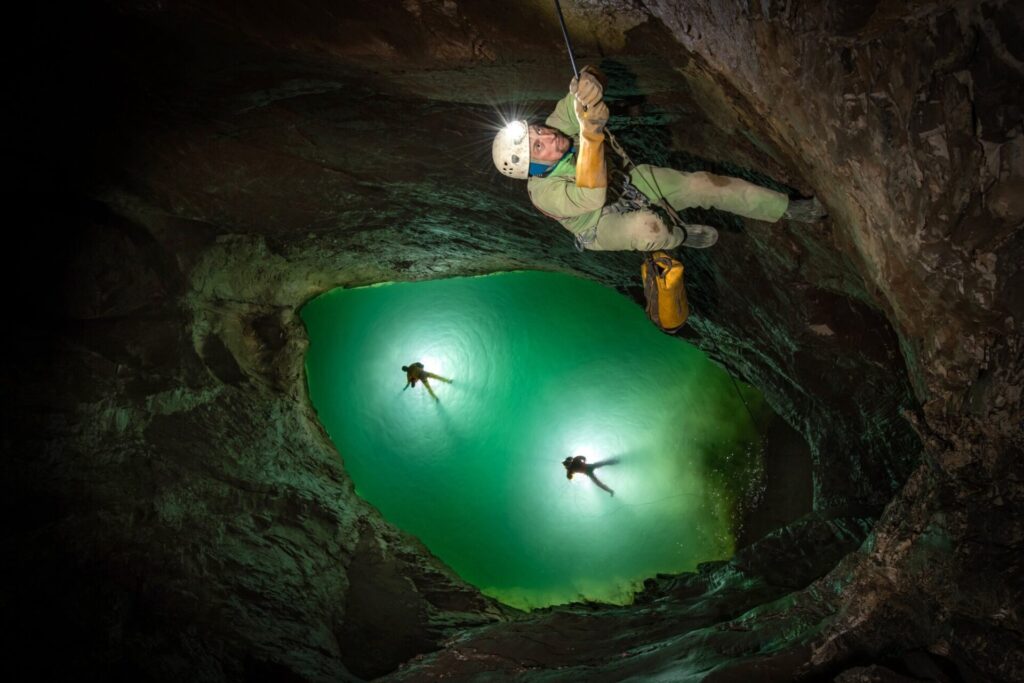
Story • Robbie Shone • May 20, 2021
Last Exit From The Secret Sea
A race against time in the world's deepest cave
